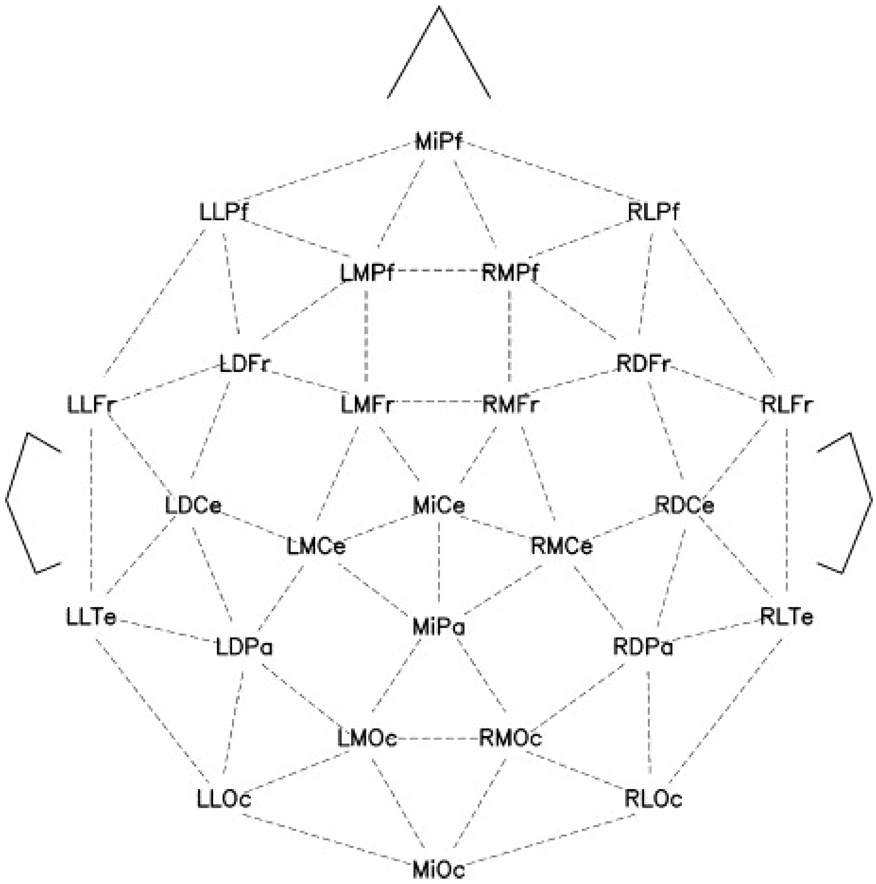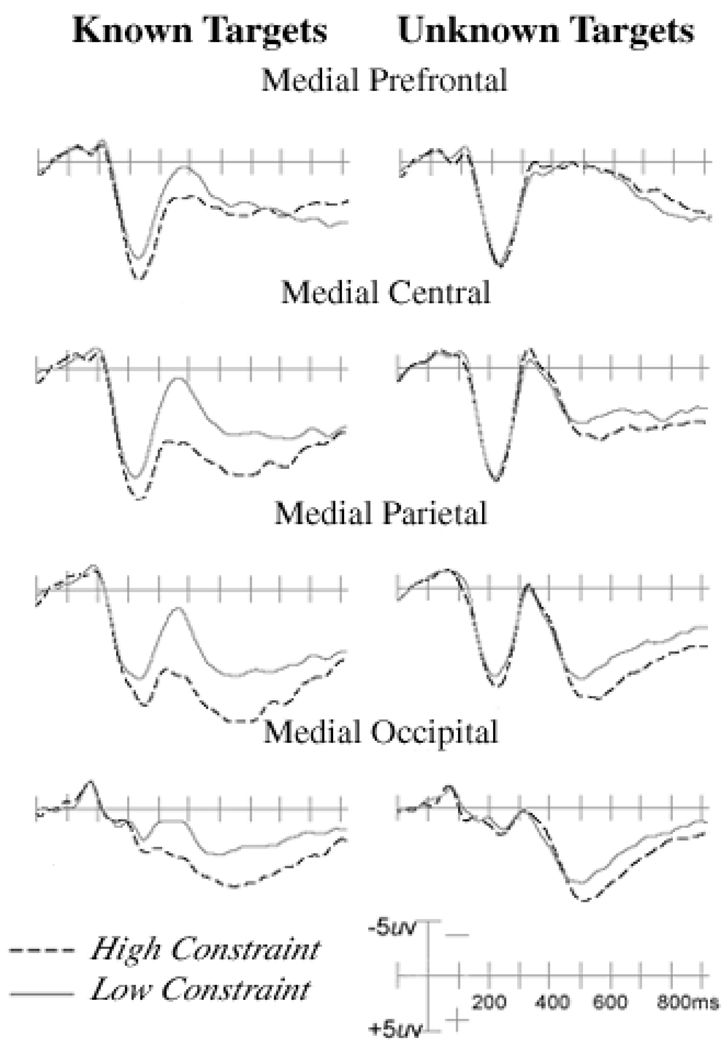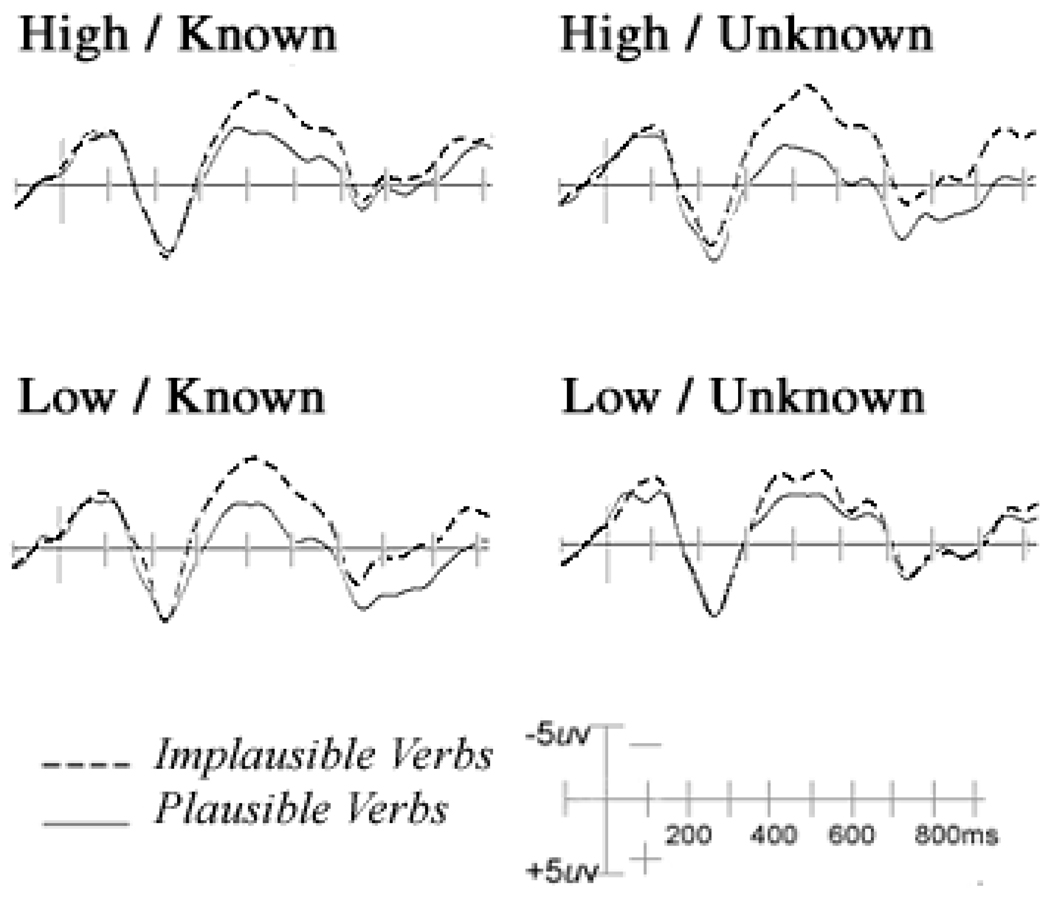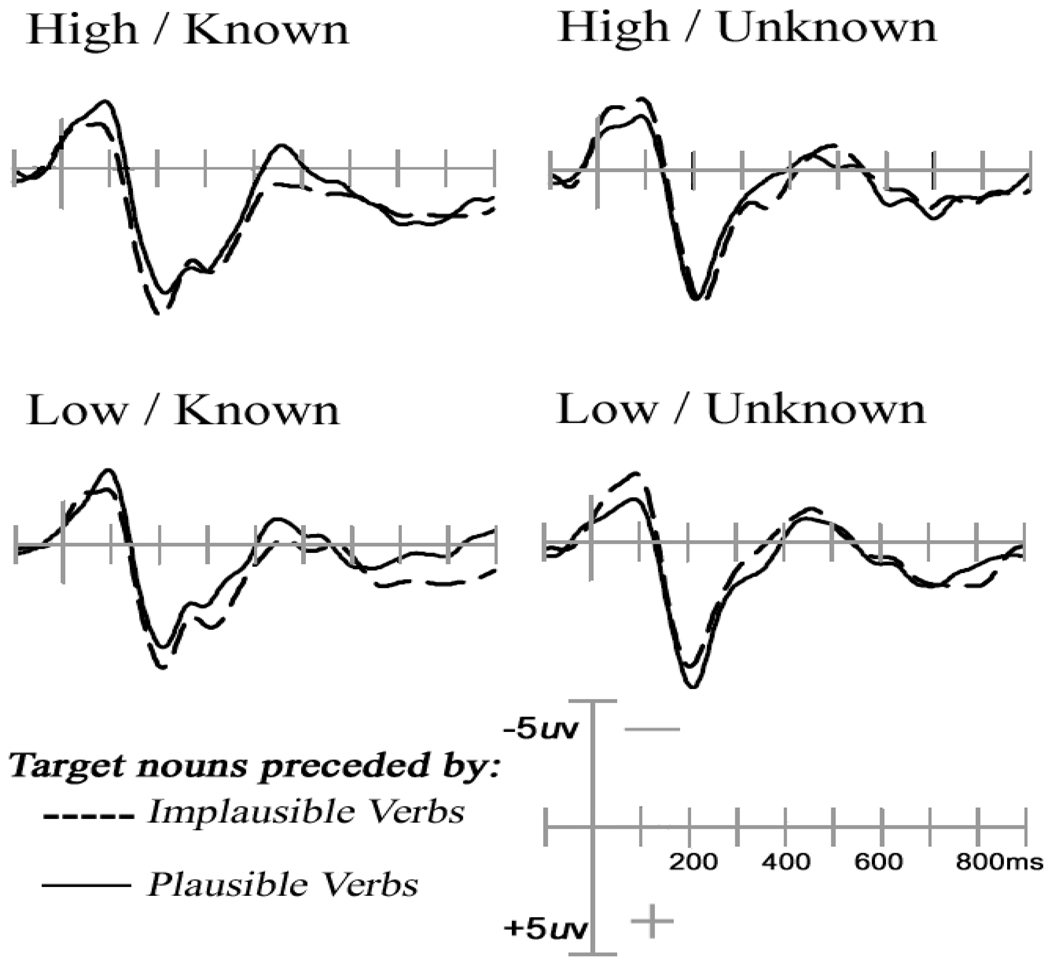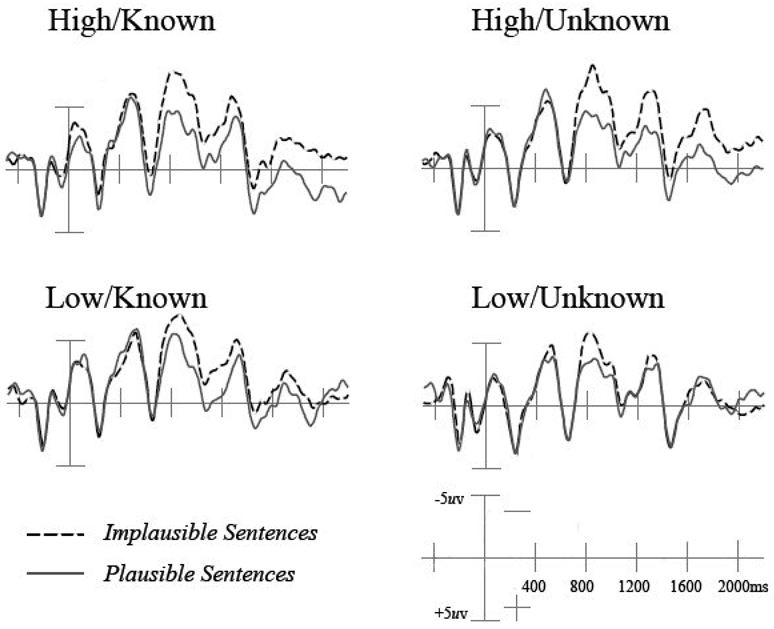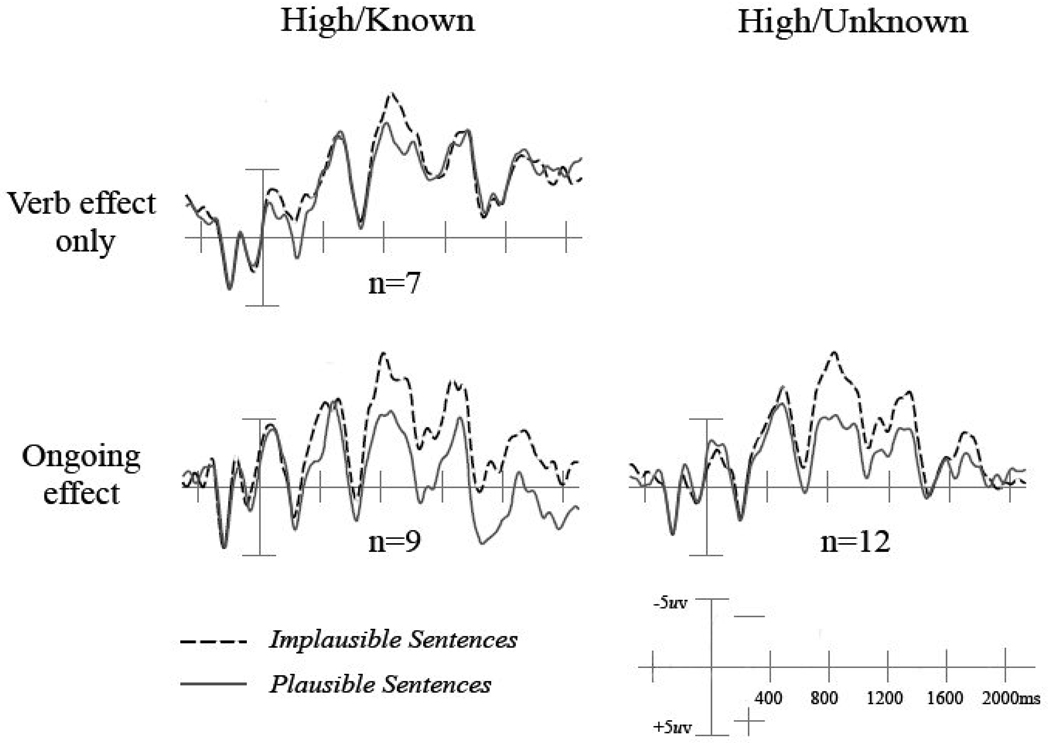Abstract
Humans have the remarkable capacity to learn words from a single instance. The goal of this study was to examine the impact of initial learning context on the understanding of novel word usage using event related brain potentials. Participants saw known and unknown words in strongly or weakly constraining sentence contexts. After each sentence context, word usage knowledge was assessed via plausibility ratings of these words as the objects of transitive verbs. Plausibility effects were observed in the N400 component to the verb only when the upcoming novel word object had initially appeared in a strongly constraining context. These results demonstrate that rapid word learning is modulated by contextual constraint and reveal a rapid mental process that is sensitive to novel word usage.
Humans have an amazing capacity to learn many thousands of words; with adult vocabularies ranging between 40,000 and 150,000 words or more (Aitchinson, 1994; Beck & McKeown, 1991; Pinker, 1994). Over the years, the primary focus of word learning has been on young children. This is understandable, given the foundational role that word learning plays in language abilities. However, relatively little is known about how adults learn new words in their native language. This is a bit surprising for several reasons. First, the overwhelming majority of words known by adults are acquired after early childhood. Second, the task itself presents somewhat different challenges for adults and children; whereas children typically map words to novel or unnamed concepts (Markman & Wachtel, 1988), adults more often learn nuanced meanings for name-known concepts (e.g. jocund/happy). Third, pre-literate children often learn words through explicit naming and reference, whereas school age children and adults generally acquire words via incidental learning situations, often involving reading (Jenkins, Stein, & Wysocki, 1984; Nagy, Herman, & Anderson, 1985; Sternberg, 1987). However, there is one important similarity between child and adult word learning, which is that it can—under the right conditions—be remarkably fast. Indeed, a single exposure to a novel word is sufficient for a learner to infer its probable meaning (Carey & Bartlett, 1978; Dollaghan, 1985).
The goal of the present research is to understand what those conditions might be, focusing on adults and the role played by sentence context, and using event-related brain potentials (ERPs) as adults read known words and unknown pseudowords in sentences that strongly or weakly constrained their meanings.
Consider, as an example, what one might infer about the meaning of a pseudoword like marf in the sentence She walked across the room to Mike’s messy desk to return his marf. Compare this with He tried to put the pieces of the broken plate back together with marf. Although both contexts provide information about the meaning and proper usage of marf, the second sentence is more highly constraining of that meaning, and thus, a more specific understanding of its usage might be inferred.
We tested this hypothesis by asking participants to rate the acceptability of the target word’s usage in two successive test sentences (always a Pronoun–Transitive Verb–Article/Pronoun–Target word) presented after a single example context sentence, e.g., They used the marf, followed by She drove the marf. Because the test sentences appeared immediately after the context sentences, and the target word always appeared in direct object position, all the information needed to determine if the word was used appropriately was available at the verb (in examples above, using a marf is plausible whereas driving one is implausible). Thus, the earliest point at which one might find plausibility effects in a test sentence would be at the verb.
We therefore measured the amplitude of the N400 ERP component elicited by the verb in these test sentences in order to determine whether or not a reader gleaned enough meaning from a novel word to decide if it is a plausible object of that verb. The N400 is a negative-going brain potential between 250–500ms (peaking ~400ms) after the presentation of any potentially meaningful stimulus (Kutas & Hillyard, 1980). N400 amplitudes are larger when a word is unknown, used inappropriately, is frequent, or is a pseudoword (Bentin, 1987; Kutas & Hillyard, 1980). The N400 is sensitive to word knowledge and learning in children (Friedrich & Friederici, 2004; Friedrich & Friederici, 2005, 2005, 2006; Mills, Coffey-Corina, & Neville, 1997; Torkildsen et al., 2006) and adults (McLaughlin, Osterhout, & Kim, 2004; Mestres-Misse, Rodriguez-Fornells, & Munte, 2006; Perfetti, Wlotko, & Hart, 2005; Stein et al., 2006). By focusing on plausibility effects on the preceding verb instead of on the repeated object word, we avoid potential confounds, including known N400 reductions with repetition (Van Petten, Kutas, Kluender, Mitchiner, & McIsaac, 1991). Moreover, we can infer if knowledge of word usage is rapidly acquired by the degree to which the N400 is modulated by the appropriateness of subsequent use of the word.
Methods
Participants
26 right-handed native English-speaking undergraduates (17 women) between 18–25 years old (mean 19.8) received credit or $7/hr for their participation. All participants had normal hearing and normal (or corrected–to-normal) vision with no history of mental illness, learning disability, language impairment, drug abuse, or neurological trauma. Eleven additional participants were not analyzed due to excessive blinking or motion artifact (4), equipment failure or experimenter error (3), or some disqualifying characteristic (3 learned a second language in childhood, 1 reported illicit drug use.)
Stimuli
A trial consisted of three sentences. The first was a context sentence, which imposed strong or weak constraints on the likely meaning of a sentence final Known or Unknown word target. This was immediately followed by two Test sentences, each of which was a plausible (P) or implausible (I) usage of the target word. All possible combinations of plausible and implausible test pairs (PP, PI, IP, II) occurred randomly and equiprobably throughout the study.
Context sentences
Eighty strongly and 80 weakly constraining sentence fragments were selected from Federmeier and Kutas (2005). Each strongly constraining sentence fragment was completed by the highest cloze probability word. The same word was a low cloze probability ending for a weakly constraining sentence fragment. In addition, each sentence pair was completed by one of 80 pseudowords, yielding four main Context conditions with 40 sentences each (examples in Table 1): 1) High constraint sentences with Known word endings (High/Known), 2) High constraint sentences with Unknown word (pseudoword) endings (High/Unknown), 3) Low constraint sentences with Known word endings (Low/Known), and 4) Low constraint sentences with Unknown word endings (Low/Unknown). Sentence-final words in the two constraint conditions were counterbalanced across versions such that the same sentence plus ending did not appear twice in any version, but all possible combinations appeared across all versions. This ensured that any differences in performance due to properties of the words were balanced across conditions.
Table 1.
Sentence examples in each of four conditions. Context sentences provided high and low constraint contexts for Known and Unknown word targets. Tests sentences could be either plausible or implausible uses of the previously presented target word, in any combination. Test sentence verbs that were used plausibly in this sentence set were used implausibly in another trial and vice versa.
| A) Context Sentences: | |
|---|---|
| High/Known: | He tried to put the pieces of the broken plate back together with GLUE. |
| High/Unknown: | He tried to put the pieces of the broken plate back together with MARF. |
| Low/Known: | She walked across the room to Mike’s messy desk to return his GLUE. |
| Low/Unknown: | She walked across the room to Mike’s messy desk to return his MARF. |
| B) Test Sentences: | |
| Plausible: | P1. They used the GLUE / MARF. |
| (Known/Unknown) | P2. He needed the GLUE / MARF. |
| Implausible: | I1. She drove the GLUE/MARF. |
| (Known/Unknown) | I2. He greeted the GLUE/MARF. |
Test sentences
Four Test sentences were created for each Context sentence pair for a plausibility judgment task. Two Test sentences involved implausible (I) usages of the target word, and two involved plausible (P) usages. On any given trial, a context sentence was followed by a random selection of two of the four possible test sentences (PP, II, IP and PI), with all combinations occurring equiprobably throughout the study, counterbalanced across versions. There were thus 40 plausible and 40 implausible test sentences for each condition. Plausibility of the Test sentences was normed with a different set of 28 participants in an unspeeded yes/no judgment task. Participants were asked to indicate if Known and Unknown target words in Test sentences were used appropriately; only sentences with greater than 75% agreement were used in the ERP study.
Procedure
Subjects participated in a single experimental session conducted in a soundproof, electrically shielded chamber, seated in front of a CRT monitor. Participants were asked to read sentences for comprehension even when nonsense or unknown words appeared. After reading the context sentence, participants then read and rated the plausibility of the two Test sentences appearing back to back, each ending with the same word as the preceding context sentence. Participants were not instructed to generate an explicit meaning for Unknown words.
Each context sentence was preceded by a row of central fixation crosses (500 ms duration with a stimulus-onset-asynchrony (SOA) varying randomly between 300–800 ms). Sentences were presented one word at a time, with all but the final word appearing for 200 ms with SOA of 500 ms. The final target word appeared for 1400 ms, and was immediately followed by the two Test sentences, to prevent participants from using an explicit naming or rehearsal strategy for novel words. Each Test sentence was preceded by a row of question marks (400 ms duration with randomly varied SOA of 100–300 ms), words appeared with identical timing as the Context sentences. Participants were asked to make a plausibility rating as quickly and as accurately as possible at the sentence end.
Recording
Scalp potentials were continuously recorded from 26 geodesically arranged sites using an ElectroCap with tin electrodes (impedances below 5 kΩ) , referenced to the left mastoid (Figure 1). Potentials were digitized at a sampling rate of 250 Hz and band pass filter of 0.1–100Hz with Grass Amplifiers
Figure 1.
Schematic of electrode placement
Data Analysis
Data were re-referenced offline to an average mastoid. Trials contaminated by eye movements, blinks, excessive muscle activity, or amplifier blocking were rejected off-line before averaging. Averages of artifact-free ERPs were computed for the target words in the four learning conditions (High/Known, High/Unknown, Low/Known, Low/Unknown) as well as to verbs and nouns in Plausible and Implausible test conditions after subtraction of the 100 ms pre-stimulus baseline.
Results
Accuracy
Behavioral and ERP responses were simultaneously collected from participants in the plausibility judgment task. Plausibility accuracy ranged between 69% and 90% (Table 2). A three factor ANOVA with factors of Constraint (Low and High), Word Type (Known and Unknown) and Plausibility (Plausible and Implausible) revealed effects of Constraint [F(1,200)=25.4, p<0.0001], with reduced accuracies for Low constraint items, and Word Type [F(1,200)=45.6, p<0.0001], with greater accuracy to Known words. There was a Constraint × Type interaction [F(1,200)=5.76, p=0.0173] and Type × Plausibility interaction [F(1,200)=15.82, p<0.0001]. Tukey analyses revealed that Known word accuracy was unaffected by Constraint whereas Unknown word accuracy were reduced in Low vs. High constraint contexts, indicating that Unknown words were harder to understand, with the greatest difficulty in the Low/Unknown condition. Results were identical when conducted on arcsin transformed percentages, ruling out explanations due to ceiling effects.
Table 2.
Accuracy of responses to plausibility task
| Condition | % Accuracy (SD) |
|---|---|
| High/Known | |
| Plausible | 90 (2.84) |
| Implausible | 88 (3.20) |
| Overall | 89 (3.02) |
| High/Unknown | |
| Plausible | 80 (4.09) |
| Implausible | 84 (3.84) |
| Overall | 82 (4.02) |
| Low/Known | |
| Plausible | 89 (2.61) |
| Implausible | 81 (3.52) |
| Overall | 85 (3.55) |
| Low/Unknown | |
| Plausible | 69 (3.12) |
| Implausible | 75 (4.54) |
| Overall | 72 (4.07) |
Context sentence ERPs
ERP brain potentials to the final words of the context sentences are shown in Figure 2.
Figure 2.
ERPs to Known and Unknown target words in Context sentences at midline electrode sites. Analyses over a restricted and a complete set of electrode sites indicate that sentential context did not modulate N400s for Unknown targets; N400 amplitudes were smallest for Known words in High constraint contexts. Additional distributional analyses indicated that N400 differences between High/Known and all other conditions were largest medially.
N400 and LPC mean amplitude
N400 mean amplitudes were measured 300–500 ms post final word onset at four centro-parietal electrode sites (RMCe, LMCe, MiCe, MiPa) where N400 effects are typically largest. A repeated measures ANOVA with factors of Word Type (Known and Unknown) and Constraint (High and Low) revealed main effects of Constraint [F(1,25)=24.92 p<0.0001], Type [F(1,25)=22.44, p<0.0001], and a Constraint × Type interaction [F(1,25)=23.45, p<0.0001]. Tukey tests indicated that these effects were driven by High/Known endings being significantly more positive than every other condition. Identical analyses including all 26 electrodes yielded the same result pattern. Thus ERPs to Known words show a modulation by sentential constraint in the N400 region, while Unknown words do not.
Additionally, an extended late positive component (LPC) was elicited for both Known and Unknown words. A repeated measures ANOVA with factors Word Type (Known and Unknown) and Constraint (High and Low) was conducted on the LPC mean amplitude between 500–700 ms post final word onset at the same recording sites. This analysis revealed effects of Constraint [F(1,25)=8.71 p=0.0068], with High (vs. Low) constraint target words showing greater positivity, and Type [F(1,25)=14.34 p=0.0009], with Known (vs. Unknown) words showing greater overall positivity. A Constraint × Type interaction [F(1,25)=14.18, p=0.0009], reflected greater positivity to High/Known targets than all other conditions, according to Tukey tests. Identical analyses with all electrodes yielded the same main effects, but no Constraint × Type interaction. In sum, there was no reliable signature in the N400 or LPC time windows suggesting differential processing of Unknown words upon their initial appearance as a function of contextual constraint.
N400 and LPC distribution
Additional analyses examined possible interactions between N400 and LPC amplitudes at various scalp locations and experimental conditions. Amplitudes were measured across 16 electrode sites (LLPf, RLPf, LMPf, RMPf, LLFr, RLFr, LMFr, RMFr, LLTe, RLTe, LMCe, RMCe, LLOc, RLOc, LMOc, RMOc). Experimental effects of Wordtype (Known and Unknown) and Constraint (High and Low) and Distributional factors of Hemisphere (Right or Left), Anteriority (Prefrontal, Frontal, Central, Occipital), Laterality (Medial or Lateral) were included in a repeated measures ANOVA analysis of N400 and LPC, summarized in Table 3. Follow-up post hoc tests indicated that main effects and interactions between experimental and distributional factors in the N400 window arose from a tendency for effects to be largest at left medial, central and frontal electrode sites. Post hoc tests for LPC effects indicated that differences between Known and Unknown words were largest at medial and more anterior sites. Additionally, High and Low constraint differences were largest at posterior and medial sites.
Table 3.
F-values of significant N400 and LPC effects of Distributional Analyses for Context Sentence Endings.
| N400 effects | LPC effects | ||||
|---|---|---|---|---|---|
| Df | F | P < | F | P < | |
| Constraint (C) | (1, 25) | 18.355 | .0001 | 13.962 | .001 |
| Wordtype (W) | (1, 25) | 24.473 | .0001 | 12.868 | .001 |
| Hemisphere (H) | (1, 25) | 16.251 | .0001 | ||
| Anteriority (A) | (3, 75) | 23.041 | .0001 | 33.314 | .0001 |
| Laterality (L) | (1, 25) | 45.423 | .0001 | 81.155 | .0001 |
| C×W | (1, 25) | 21.619 | .0001 | ||
| C × H | (1, 25) | 4.736 | .039 | ||
| C × A | (3, 75) | 10.762 | .0001 | ||
| C × L | (1, 25) | 12.816 | .001 | 19.316 | .0001 |
| W × H | (1, 25) | 15.395 | .001 | 9.109 | .006 |
| W × A | (3, 75) | 15.179 | .0001 | 32.977 | .0001 |
| W × L | (1, 25) | 18.871 | .0001 | 12.583 | .002 |
| H × A | (3, 75) | ||||
| H × L | (1, 25) | 4.327 | .048 | 15.810 | .001 |
| A × L | (3, 75) | 19.057 | .0001 | ||
| C × W × L | (1, 25) | 28.667 | .0001 | ||
| C × H × A | (3, 75) | 3.026 | .035 | 9.705 | .0001 |
| C × A × L | (3, 75) | 5.333 | .002 | ||
| W × H × A | (3, 75) | 5.207 | .003 | ||
| W × H × L | (1, 25) | 10.014 | .004 | ||
| W × A × L | (3, 75) | 3.452 | .021 | ||
| H × A × L | (3, 75) | 4.030 | .010 | 5.727 | .001 |
| C × W × H × A | (3, 75) | 3.828 | .013 | ||
| C × W × A × L | (3, 75) | 5.541 | .002 | ||
| C × H × A × L | (3, 75) | 3.560 | .018 | ||
| W × H × A × L | (3, 75) | 8.913 | .0001 | 6.871 | .0001 |
Interactions that did not yield significant N400 or LPC effects are omitted
Plausibility ERP effects
Figures 3 and 4 show ERPs to verbs (Fig. 3) and sentence final words (Fig. 4) in Test sentences. Recall that all the information needed for a plausibility judgment first becomes available at the verb preceding the target noun. Figure 3 demonstrates that participants rapidly assessed plausibility, as indexed by effects at the verb.
Figure 3.
Plausibility effect for Verbs preceding Known and Unknown targets. ERPs at right-medial central electrode (RMCe) are plotted for plausible and implausible verbs in each condition.
Figure 4.
Plausibility effect for Known and Unknown targets. Event-related potentials at right-medial central electrode (RMCe) are plotted for Known and Unknown targets preceded by plausible and implausible verbs. Unlike their preceding verbs, no significant plausibility effects were observed for Known and Unknown word targets in N400 or LPC component timewindows.
N400 and LPC amplitude
N400 and LPC amplitudes for plausible and implausible verbs were measured at four centrally located electrode sites (RMCE, LMCE, MiCe, MiPa) and subjected to a repeated measures ANOVA with factors of Word Type (Known and Unknown) and Constraint (High and Low) and Plausibility (Plausible and Implausible). For the N400, there was a main effect of Plausibility [F(1,25)=46.5553, p<0.0001] reflecting smaller N400s to Plausible (vs. Implausible) verbs. There was also a significant three-way interaction of Constraint × Type × Plausibility [F(1,25)=5.1258, p<0.0325]. Tukey tests revealed plausibility effects in N400 amplitude in all conditions except Low/Unknown 1, suggesting that adults are able to infer the meaning of novel word meanings after a single presentation, but only when unknown words initially appear in strongly constraining contexts. Identical analyses conducted on sentence final words revealed no significant effects of plausibility.
N400 and LPC distribution
Additional analyses for verbs were also carried out on 16 electrodes across the scalp. In addition to Constraint, Type and Plausibility, Distributional factors of Hemisphere, Anteriority and Laterality were analyzed in two repeated measures ANOVAs for mean N400 and LPC amplitudes (see Table 4). N400 main effects and interactions of distributional factors were driven by a tendency for the N400 to be larger in the right hemisphere, over central and lateral scalp locations. The distributions of the N400 involved in plausibility judgments in Known and Unknown conditions, however, were very similar. Post hoc tests indicated that LPC effects were driven by a tendency for plausibility differences to be larger over medial and central and frontal electrodes and for the LPC plausibility differences to be largest for High/Unknown and Low/Known words.
Table 4.
F-values of significant N400 and LPC effects of distributional analyses for verbs in plausibility sentences.*
| N400 effects | LPC effects | ||||
|---|---|---|---|---|---|
| Df | F | P < | F | P < | |
| Constraint (C) | (1, 25) | 5.510 | .027 | ||
| Wordtype (W) | (1, 25) | ||||
| Plausibility (P) | (1, 25) | 46.026 | .0001 | 17.119 | .000 |
| Hemisphere (H) | (1, 25) | 33.680 | .0001 | 18.335 | .0001 |
| Anteriority (A) | (3, 75) | 25.980 | .0001 | 17.527 | .0001 |
| Laterality (L) | (1, 25) | 8.443 | .008 | 10.985 | .003 |
| C×W | (1, 25) | 8.202 | .008 | ||
| P × A | (3, 75) | 3.811 | .013 | 4.362 | .007 |
| P × L | (1, 25) | 22.688 | .0001 | 7.758 | .010 |
| H × A | (3, 75) | 3.341 | .024 | 2.804 | .046 |
| H × L | (1, 25) | 12.142 | .002 | ||
| A × L | (3, 75) | 8.431 | .0001 | 5.362 | .002 |
| C × W × P | (1, 25) | 6.865 | .015 | 5.137 | .032 |
| C × W × L | (1, 25) | 17.113 | .0001 | ||
| C × P × H | (1, 25) | ||||
| C × P × A | (3, 75) | 5.680 | .001 | 3.132 | .031 |
| P × A × L | (3, 75) | 3.689 | .016 | 4.427 | .006 |
| C × W × P × A | (3, 75) | 2.786 | .047 | ||
| C × W × H × L | (1, 25) | 4.370 | .047 | ||
| C × W × P × H × A | (3, 75) | 4.359 | .007 | ||
Interactions that did not yield significant LPC or N400 effects are omitted
For the LPC, High/Unknown and Low/Known words seem to pattern together with larger positivities for plausible verbs. However, there was no a three way interaction of Constraint × Wordtype × Plausibility, nor any reliable post hoc plausibility differences.
Plausibility effects over the test sentences
In order to track plausibility effects across time, Figure 5 shows ERPs over the entire test sentence epoch, suggesting that plausibility effects were not restricted to the verb, perhaps continuing to sentence end. Unlike the single (final) word ERP, these over-sentence averages offer a view of the sentence plausibility ERP effect that takes into account preceding condition differences (like those starting at the verb). Unlike the reliable N400 plausibility effects at the verb, there was considerable variability in the post-verb ERPs. One-third to one-half of the participants in each of the three other conditions exhibited post-verbal negative plausibility effects (greater negativity for implausible than plausible sentences) that lasted through sentence end (which is not visible if the baseline for comparison for the final word is 100 ms pre-final word). For another 7 participants, the plausibility effect in the Hi/Known condition was limited to the verb (see Figure 6). The remaining participants exhibited either no or reversed post-verb plausibility effects, or effects that were inconsistent from word to word.
Figure 5.
Grand average ERPs to test sentences in their entirety across all participants. N400 effects are evident for each sentence item sequentially: at 400 ms for the pronoun, 800ms for the verb, 1200ms for the article, and 1600ms for the final test noun.
Figure 6.
Example of grand average ERPs to test sentences where participants show two different patterns: 1) plausibility effects at the verb only (in High/Known only), and 2) continuing effects across the sentence. Like in Figure 5, N400 effects are shown for each sentence item sequentially, beginning with the pronoun at 400ms.
Discussion
Our results suggest that adults learn the implied meaning of novel words via a process that is sensitive to contextual constraint. Furthermore, the newly acquired knowledge is integrated into existing verb-argument relationships. One exposure in a highly constraining context seems sufficient to impart whether or not a previously unknown word can serve as the object of particular verbs. The ERP data reveal that this knowledge about a newly experienced word is deployed rapidly in real-time sentence processing. Others have explored neural signatures of word learning over multiple exposures (Mestres-Misse et al., 2006) or extended training (McLaughlin et al., 2004; Ojima, Nakata, & Kakigi, 2005; Perfetti et al., 2005; Stein et al., 2006), but to our knowledge, this is the first report of the ERP indices of one-shot word learning in adults.
Upon initial presentation in the context sentences, only Known words showed an N400 constraint effect, with smaller amplitudes under high than low constraint whereas Novel words did not. However, the impact of the initial learning context (including the target word) is clearly evident in the N400 amplitude modulation during the processing of the verb of the subsequent Test sentence. Following initial exposure under strong (but not weak) constraint, verb N400s were significantly smaller if that verb could plausibly take the novel word as an object than if it could not. Our interpretation is that this effect reflects knowledge of novel word meaning that is driven by its initial exposure in context.
One alternate interpretation is that this effect may have little to do with word learning but is carried instead by the preceding sentence context. Under this account, some aspect of the contextual information that remains active in working memory drives the plausibility effect at the verb, rather than, as we propose, the newly learned word. If so, then we might predict similar results even if the same novel word were used in every sentence (e.g., MARF) or if there were no final word for the context sentence (e.g., the context word was replaced by question marks)2. We have not conducted these studies. Nonetheless, we have reasons to think that our effects are due to word learning. In our study, participants read a highly constraining sentence about repairing a broken plate with glue or marf, and then encountered a verb such as "used" or "drove" (see Table 1). According to the alternative account, it is the presumably greater mismatch between "drove" and the "broken plate repairing event" than "used" that leads to the observed N400 effect at the verb in the text sentence. If this going on, it also likely to apply to the greater mismatch between "drove" than "used" in "the messy office scene" set up by the less contextually constraining sentence (see Table 1). Yet, the N400 plausibility effect is only evident when the novel word was initially experienced under high contextual constraint. Moreover, it does seem that known context words alone can drive the verb plausibility effects; using LSA to estimate the strength of the semantic relationship between the learning sentence context fragment (all but the final words) and the test sentence verb, we find no reliable differences across conditions -- either due to constraint or plausibility. This contrasts with the significant plausibility effect in the LSA scores between the final (target) words of the context sentences and the test sentence verbs: as expected, the similarity scores are greater for plausible than implausible verbs (we could not assess the effect of constraint as the same target words appeared in both constraint conditions). In sum, although the alternative remains a logical possibility, we think that our participants were attempting to fit the meaning of the upcoming object with the verb, which is stronger/more accessible (i.e., better learned) in the higher constraint condition, and it is this mismatch, not just that with the general context that drives the verb N400 amplitude. Even stronger evidence against this alternative comes from a similar follow-up study with multiple intervening items between the context and test (Borovsky, Elman & Kutas, in prep). In that study, we find N400 evidence of word learning over a several minute delay. For these reasons, although the alternative account remains a possibility, we believe it is unlikely.
Interestingly, N400 amplitude modulations were found at the verb and not the target words in the Test sentences although behavioral plausibility judgments were neither required nor given until the completion of the Test sentences. These effects show that semantic analyses needed for plausibility were computed as soon as possible, which is consistent with incremental views of sentence processing (Altmann & Kamide, 1999; Kamide, Altmann, & Haywood, 2003). More specifically, the N400 verb effect demonstrates that novel word knowledge was immediately coordinated with verb-argument restrictions, but only when the novel word had been presented in a highly constrained context. When the novel word meaning was only weakly constrained, there was no reliable plausibility N400 effect at the test verb. This indicated that the semantic representations subserving the plausibility judgment were incomplete or underspecified. In short, after a single highly constrained exposure, the mental representation of an unknown word is rapidly incorporated into the lexical and grammatical systems of participants’ language processing system.
The current study focused on the role of contextual constraint on rapid word learning. Naturally, other factors like topic knowledge, word concreteness, or part of speech can influence word learning (Jenkins & Dixon, 1983). As we aimed to minimize the influence of word-specific factors, we exposed participants to novel nouns (pseudowords) with the intended meanings of highly familiar concepts (i.e., marf as a synonym for glue). Future research will need to address how context interacts with other such lexico-semantic factors during word acquisition.
In sum, we find that experience matters when learning how to use a word. This effect can shed light on problems encountered by language learners, such as why some words are more easily learned, and it suggests a method of measuring newly acquired lexical knowledge without requiring a response.
Acknowledgements
AB was supported by an NSF graduate fellowship and NIH training grant DC00041. This work was also funded by R01 MH60517 and R01 HD053136 to JE and RO1 AG08313-O1A1 and R01 NICHD22614 to MK. We also wish to thank three anonymous reviewers for their helpful feedback on a previous version of this manuscript.
Footnotes
Publisher's Disclaimer: This is a PDF file of an unedited manuscript that has been accepted for publication. As a service to our customers we are providing this early version of the manuscript. The manuscript will undergo copyediting, typesetting, and review of the resulting proof before it is published in its final citable form. Please note that during the production process errors may be discovered which could affect the content, and all legal disclaimers that apply to the journal pertain.
The same main effects, interactions, and post-hoc test results were observed in a separate set of analyses conducted over the entire set of 26 electrodes.
We thank an anonymous reviewer for pointing this out.
References
- Aitchinson J. Words in the mind: An introduction to the mental lexicon. 2nd ed. Oxford: Blackwell; 1994. [Google Scholar]
- Altmann GTM, Kamide Y. Incremental interpretation at verbs: Restricting the domain of subsequent reference. Cognition. 1999;73:247–264. doi: 10.1016/s0010-0277(99)00059-1. [DOI] [PubMed] [Google Scholar]
- Beck IL, McKeown MG. Conditions of vocabulary acquisition. In: Barr R, Kamil M, Mosenthal P, Pearson PD, editors. Handbook of reading research. Vol. 2. New York: Longman; 1991. pp. 789–814. [Google Scholar]
- Bentin S. Event-related potentials, semantic processes, and expectancy factors in word recognition. Brain & Language. 1987;31(2):308–327. doi: 10.1016/0093-934x(87)90077-0. [DOI] [PubMed] [Google Scholar]
- Carey S, Bartlett E. Acquiring a single new word. Papers and Reports on Child Language Development. 1978;15:17–29. [Google Scholar]
- Dollaghan C. Child Meets Word: "Fast Mapping" in Preschool Children. J Speech Hear Res. 1985;28(3):449–454. [PubMed] [Google Scholar]
- Federmeier KD, Kutas M. Aging in context: Age-related changes in context use during language comprehension. Psychophysiology. 2005;42(2):133–141. doi: 10.1111/j.1469-8986.2005.00274.x. [DOI] [PubMed] [Google Scholar]
- Friedrich M, Friederici AD. N400-like Semantic Incongruity Effect in 19-Month-Olds: Processing Known Words in Picture Contexts. J. Cogn. Neurosci. 2004;16(8):1465–1477. doi: 10.1162/0898929042304705. [DOI] [PubMed] [Google Scholar]
- Friedrich M, Friederici AD. Lexical priming and semantic integration reflected in the event-related potential of 14-month-olds. Neuroreport. 2005;16(6):653–656. doi: 10.1097/00001756-200504250-00028. [DOI] [PubMed] [Google Scholar]
- Friedrich M, Friederici AD. Semantic sentence processing reflected in the event-related potentials of one- and two-year-old children. Neuroreport. 2005;16(16):1801–1804. doi: 10.1097/01.wnr.0000185013.98821.62. [DOI] [PubMed] [Google Scholar]
- Friedrich M, Friederici AD. Early N400 development and later language acquisition. Psychophysiology. 2006;43(1):1–12. doi: 10.1111/j.1469-8986.2006.00381.x. [DOI] [PubMed] [Google Scholar]
- Jenkins JR, Dixon R. Vocabulary Learning. Contemporary Educational Psychology. 1983;8(3):237–260. [Google Scholar]
- Jenkins JR, Stein ML, Wysocki K. Learning Vocabulary Through Reading. American Educational Research Journal. 1984;21(4):767–787. [Google Scholar]
- Kamide Y, Altmann GTM, Haywood S. The time-course of prediction in incremental sentence processing: Evidence from anticipatory eye movements. Journal of Memory & Language. 2003;49:133–156. [Google Scholar]
- Kutas M, Hillyard SA. Reading senseless sentences: Brain potentials reflect semantic incongruity. Science. 1980;207(4427):203–205. doi: 10.1126/science.7350657. [DOI] [PubMed] [Google Scholar]
- Markman EM, Wachtel GF. Children's use of mutual exclusivity to constrain the meanings of words. Cognitive Psychology. 1988;20(2):121–157. doi: 10.1016/0010-0285(88)90017-5. [DOI] [PubMed] [Google Scholar]
- McLaughlin J, Osterhout L, Kim A. Neural correlates of second-language word learning: minimal instruction produces rapid change. Nat Neurosci. 2004;7(7):703–704. doi: 10.1038/nn1264. [DOI] [PubMed] [Google Scholar]
- Mestres-Misse A, Rodriguez-Fornells A, Munte TF. Watching the Brain during Meaning Acquisition. Cereb. Cortex. 2006:bhl094. doi: 10.1093/cercor/bhl094. [DOI] [PubMed] [Google Scholar]
- Mills DL, Coffey-Corina S, Neville HJ. Language comprehension and cerebral specialization from 13 to 20 months. Developmental Neuropsychology. 1997;13(3):397–445. [Google Scholar]
- Nagy WE, Herman PA, Anderson RC. Learning Words from Context. Reading Research Quarterly. 1985;20(2):233–253. [Google Scholar]
- Ojima S, Nakata H, Kakigi R. An ERP Study of Second Language Learning after Childhood: Effects of Proficiency. J. Cogn. Neurosci. 2005;17(8):1212–1228. doi: 10.1162/0898929055002436. [DOI] [PubMed] [Google Scholar]
- Perfetti CA, Wlotko EW, Hart LA. Word learning and individual differences in word learning reflected in event-related potentials. J Exp Psychol Learn Mem Cogn. 2005;31(6):1281–1292. doi: 10.1037/0278-7393.31.6.1281. [DOI] [PubMed] [Google Scholar]
- Pinker S. The language instinct: The new science of language and mind. London: Penguin; 1994. [Google Scholar]
- Stein M, Dierks T, Brandeis D, Wirth M, Strik W, Koenig T. Plasticity in the adult language system: A longitudinal electrophysiological study on second language learning. NeuroImage. 2006;33(2):774–783. doi: 10.1016/j.neuroimage.2006.07.008. [DOI] [PubMed] [Google Scholar]
- Sternberg RJ. Most vocabulary is learned from context. In: McKeown MG, Curtis ME, editors. The Nature of Vocabulary Acquisition. Hillsdale, New Jersey: Lawrence Erlbaum Associates; 1987. pp. 89–106. [Google Scholar]
- Torkildsen JvK, Sannerud T, Syversen G, Thormodsen R, Simonsen HG, Moen I, Smith L, Lindgren M. Semantic organization of basic-level words in 20-month-olds: An ERP study. Journal of Neurolinguistics. 2006;19(6):431–454. [Google Scholar]
- Van Petten C, Kutas M, Kluender R, Mitchiner M, McIsaac H. Fractionating the word repetition effect with event-related potentials. Journal of Cognitive Neuroscience. 1991;3(2):131–150. doi: 10.1162/jocn.1991.3.2.131. [DOI] [PubMed] [Google Scholar]



